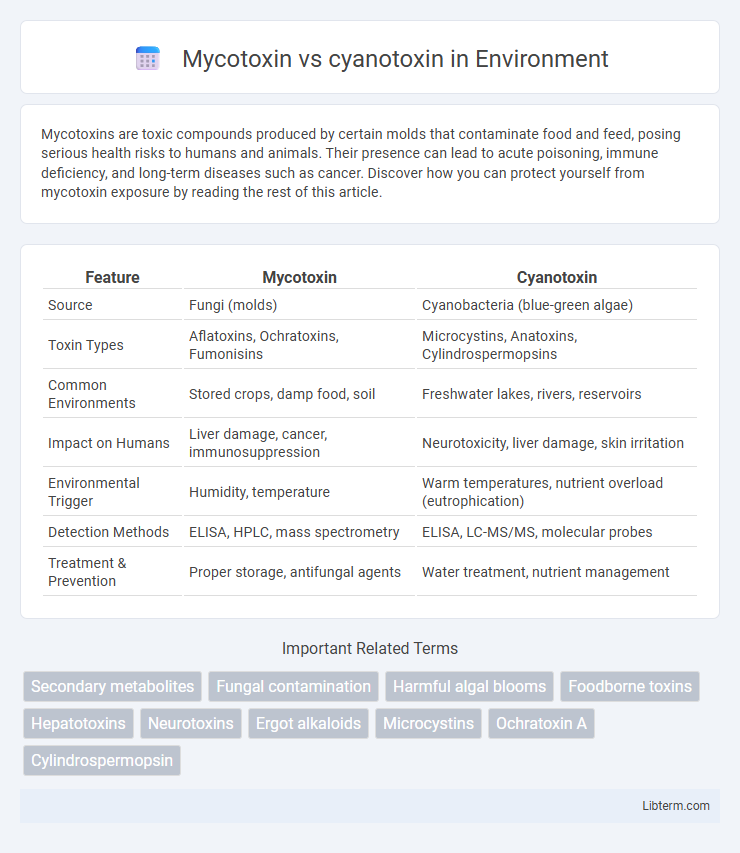Mycotoxins are toxic compounds produced by certain molds that contaminate food and feed, posing serious health risks to humans and animals. Their presence can lead to acute poisoning, immune deficiency, and long-term diseases such as cancer. Discover how you can protect yourself from mycotoxin exposure by reading the rest of this article.
Table of Comparison
| Feature | Mycotoxin | Cyanotoxin |
|---|---|---|
| Source | Fungi (molds) | Cyanobacteria (blue-green algae) |
| Toxin Types | Aflatoxins, Ochratoxins, Fumonisins | Microcystins, Anatoxins, Cylindrospermopsins |
| Common Environments | Stored crops, damp food, soil | Freshwater lakes, rivers, reservoirs |
| Impact on Humans | Liver damage, cancer, immunosuppression | Neurotoxicity, liver damage, skin irritation |
| Environmental Trigger | Humidity, temperature | Warm temperatures, nutrient overload (eutrophication) |
| Detection Methods | ELISA, HPLC, mass spectrometry | ELISA, LC-MS/MS, molecular probes |
| Treatment & Prevention | Proper storage, antifungal agents | Water treatment, nutrient management |
Introduction to Mycotoxins and Cyanotoxins
Mycotoxins are toxic secondary metabolites produced by certain molds, primarily Aspergillus, Fusarium, and Penicillium species, commonly found in agricultural commodities such as grains and nuts. Cyanotoxins are harmful compounds synthesized by cyanobacteria (blue-green algae) in aquatic environments, including microcystins and anatoxins that pose risks to water quality and human health. Both mycotoxins and cyanotoxins exhibit potent toxicity, leading to food safety issues and environmental hazards requiring rigorous monitoring and control strategies.
Sources and Origins of Mycotoxins
Mycotoxins are toxic secondary metabolites produced primarily by filamentous fungi such as Aspergillus, Fusarium, and Penicillium species, commonly found in agricultural crops like grains, nuts, and fruits under warm and humid conditions. These toxins originate from fungal contamination during crop growth, harvest, storage, and processing stages, leading to contamination in food and feed products. In contrast, cyanotoxins arise from harmful algal blooms of cyanobacteria in aquatic environments, representing a different ecological source and toxin profile.
Sources and Origins of Cyanotoxins
Cyanotoxins originate primarily from cyanobacteria found in freshwater and marine environments, often proliferating during harmful algal blooms under warm, nutrient-rich conditions. These toxins include microcystins, anatoxins, and saxitoxins, produced by species such as Microcystis, Anabaena, and Aphanizomenon. Unlike mycotoxins, which are fungal metabolites, cyanotoxins emerge from photosynthetic bacteria, emphasizing their distinct ecological sources and environmental impacts.
Chemical Structure Comparison
Mycotoxins are secondary metabolites produced by fungi, primarily comprising complex polyketides, non-ribosomal peptides, and terpenoids, characterized by diverse cyclic and aromatic structures. Cyanotoxins are toxins synthesized by cyanobacteria, including alkaloids, peptides, and lipopolysaccharides, often featuring small cyclic peptides (e.g., microcystins) or alkaloid frameworks (e.g., anatoxins). Chemical structure comparison reveals mycotoxins often possess larger, more varied ring systems with polyketide or peptide backbones, while cyanotoxins typically include stable cyclic peptides or alkaloid components with distinct nitrogenous heterocycles.
Mechanisms of Toxicity
Mycotoxins exert toxicity primarily through the inhibition of protein synthesis, oxidative stress induction, and disruption of cellular membranes, leading to hepatotoxicity, immunosuppression, and carcinogenic effects. Cyanotoxins disrupt physiological functions via neurotoxic pathways by blocking ion channels, hepatotoxic effects through protein phosphatase inhibition, and cytotoxicity resulting from reactive oxygen species generation. Both toxin types interfere with critical cellular processes, but mycotoxins typically target metabolic enzymes while cyanotoxins often affect nervous system signaling and liver function.
Health Effects on Humans and Animals
Mycotoxins, toxic compounds produced by certain molds such as Aspergillus and Fusarium species, primarily cause liver damage, immunosuppression, and carcinogenic effects in humans and animals. Cyanotoxins, including microcystins and anatoxins generated by cyanobacteria in contaminated water, lead to neurotoxicity, liver failure, and acute poisoning symptoms. Both toxins pose significant health risks through contaminated food and water sources, necessitating rigorous monitoring and control measures to prevent outbreaks and chronic exposure.
Food and Water Contamination Risks
Mycotoxins, produced by fungi, primarily contaminate food crops like grains, nuts, and dried fruits, posing significant health risks through ingestion. Cyanotoxins originate from cyanobacteria blooms in freshwater sources, leading to contamination of drinking water and recreational waters, raising concerns over toxic exposure in humans and animals. Both toxins threaten food and water safety, requiring rigorous monitoring and management to prevent contamination and safeguard public health.
Detection and Monitoring Methods
Detection and monitoring methods for mycotoxins primarily involve chromatographic techniques such as HPLC and LC-MS/MS, which offer high sensitivity and specificity for identifying compounds like aflatoxins and ochratoxins in food products. Cyanotoxin detection relies heavily on immunoassays like ELISA, along with advanced methods such as liquid chromatography coupled with tandem mass spectrometry (LC-MS/MS), to identify microcystins and anatoxins in water sources. Emerging biosensor technologies and molecular tools like qPCR enhance real-time monitoring capabilities for both mycotoxins and cyanotoxins, improving early detection and risk assessment in environmental and food safety contexts.
Prevention and Control Strategies
Mycotoxin prevention and control strategies emphasize proper crop storage, moisture control, and the use of resistant crop varieties to reduce fungal contamination. Cyanotoxin management focuses on monitoring water quality, limiting nutrient runoff to prevent algal blooms, and employing water treatment processes such as activated carbon filtration and ozonation. Integrated approaches combining environmental monitoring, agricultural best practices, and advanced filtration technologies are essential to effectively mitigate risks posed by both mycotoxins and cyanotoxins.
Regulatory Standards and Safety Guidelines
Regulatory standards for mycotoxins, such as aflatoxins and ochratoxins, are established by bodies like the FDA and EFSA with strict limits in food and feed to prevent toxic exposure. Cyanotoxin regulation, including microcystins and cylindrospermopsin, is governed by agencies like the WHO and EPA with specific guidelines for drinking water safety due to their occurrence in harmful algal blooms. Safety guidelines emphasize regular monitoring, risk assessment, and mitigation strategies to ensure public health protection against both mycotoxin contamination in foodstuffs and cyanotoxin presence in water sources.
Mycotoxin Infographic

 libterm.com
libterm.com